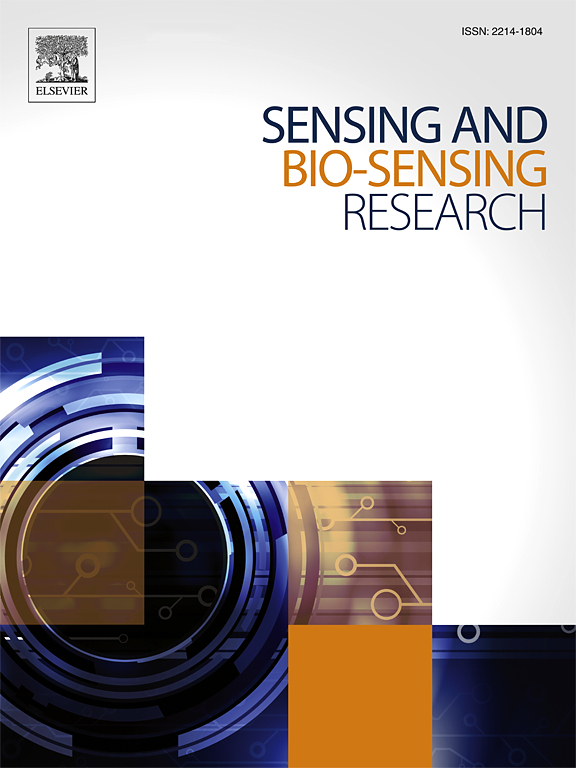Eco-friendly electrochemical sensing: An ultra-sensitive voltammetric analysis of ciprofloxacin in human serum, cow's milk and pharmaceutical samples using a glassy carbon electrode modified with poly(Na2[Cu(HR)4])
IF 4.9
Q1 CHEMISTRY, ANALYTICAL
引用次数: 0
Abstract
Recent advances in electrochemistry and electrode surface modification highlight the potential of transition metal coordination compounds as effective modifiers. This study presents sodium tetraresorcinolatocuprate(II) (Na₂[Cu(HR)₄]), a newly synthesized compound characterized using UV–Vis, FT-IR spectroscopy, ICP OES, and melting point analysis. A poly(Na₂[Cu(HR)₄])/GCE was fabricated via potentiodynamic techniques, with cyclic voltammetry and electrochemical impedance spectroscopy confirming the formation of a polymer film that enhanced the electrode's active area and electrocatalytic properties. The developed poly(Na₂[Cu(HR)₄])/GCE was applied for determination of ciprofloxacin (CPF), an antibiotic prone to resistance issues, that requires reliable monitoring in pharmaceutical and biological samples. The poly(Na₂[Cu(HR)₄]) modifier significantly improved CPF detection by reducing its oxidation potential and increasing current response by eightfold compared to unmodified electrodes, suggesting the modifier's catalytic role in CPF oxidation. Differential pulse voltammetry (DPV) showed a linear CPF response over concentrations of 1.0 × 10−8 to 4.0 × 10−4 M, with detection and quantification limits of 2.0 nM and 6.8 nM, respectively. Analysis of commercial CPF brands showed 98.05–100.00 % accuracy, while spike recovery rates (99.25–100.40 %) and low interference errors (<4.6 %) validated the developed method for complex samples. The presented method is generally useful for determination of electroactive species in real complex samples and may aid in the design of more efficient electrochemical sensors.

生态友好型电化学传感:用聚(Na2[Cu(HR)4])修饰的玻碳电极对人血清、牛奶和药品样品中的环丙沙星进行超灵敏伏安分析
电化学和电极表面改性的最新进展突出了过渡金属配位化合物作为有效改性剂的潜力。采用紫外可见光谱(UV-Vis)、傅里叶红外光谱(FT-IR)、ICP - OES和熔点分析等方法对新合成的四聚硅酸钠(Na₂[Cu(HR)₄])进行了表征。通过动电位法制备了聚(Na₂[Cu(HR)₄])/GCE,循环伏安法和电化学阻抗谱证实了聚合物膜的形成,提高了电极的活性面积和电催化性能。将建立的聚(Na₂[Cu(HR)₄])/GCE用于环丙沙星(CPF)的检测,该抗生素是一种易出现耐药性问题的抗生素,在制药和生物样品中需要可靠的监测。与未修饰电极相比,聚Na₂[Cu(HR)₄]改性剂降低了CPF的氧化电位,并将电流响应提高了8倍,从而显著提高了CPF的检测效果,表明该改性剂在CPF氧化中的催化作用。差分脉冲伏安法(DPV)在1.0 × 10−8 ~ 4.0 × 10−4 M浓度范围内呈线性CPF响应,检测限为2.0 nM,定量限为6.8 nM。分析商品CPF品牌的准确度为98.05 - 100.00%,峰值回收率(99.25 - 100.40%)和低干扰误差(< 4.6%)验证了所开发的方法对复杂样品的有效性。该方法一般适用于实际复杂样品中电活性物质的测定,并有助于设计更有效的电化学传感器。
本文章由计算机程序翻译,如有差异,请以英文原文为准。
求助全文
约1分钟内获得全文
求助全文
来源期刊

Sensing and Bio-Sensing Research
Engineering-Electrical and Electronic Engineering
CiteScore
10.70
自引率
3.80%
发文量
68
审稿时长
87 days
期刊介绍:
Sensing and Bio-Sensing Research is an open access journal dedicated to the research, design, development, and application of bio-sensing and sensing technologies. The editors will accept research papers, reviews, field trials, and validation studies that are of significant relevance. These submissions should describe new concepts, enhance understanding of the field, or offer insights into the practical application, manufacturing, and commercialization of bio-sensing and sensing technologies.
The journal covers a wide range of topics, including sensing principles and mechanisms, new materials development for transducers and recognition components, fabrication technology, and various types of sensors such as optical, electrochemical, mass-sensitive, gas, biosensors, and more. It also includes environmental, process control, and biomedical applications, signal processing, chemometrics, optoelectronic, mechanical, thermal, and magnetic sensors, as well as interface electronics. Additionally, it covers sensor systems and applications, µTAS (Micro Total Analysis Systems), development of solid-state devices for transducing physical signals, and analytical devices incorporating biological materials.
 求助内容:
求助内容: 应助结果提醒方式:
应助结果提醒方式:


